Boston
American rock group
American rock group that was as well known for the lengthy periods between its albums as for its unique heavy metal–pop sound. The original members were Tom Scholz (b. March 10, 1947, Toledo, Ohio, U.S.), Brad Delp (b. June 12, 1951, Boston, Mass., U.S.—found dead March 9, 2007, Atkinson, N.H.), Fran Sheehan (b. March 26, 1949, Boston), Barry Goudreau (b. Nov. 29, 1951, Boston), and John (“Sib”) Hashian (b. Aug. 17, 1949, Boston).
Boston burst onto the pop music scene in 1976 with the meticulously crafted single “More Than a Feeling,” which combined elements of progressive rock (art rock) and 1960s pop. Generating three American Top 40 hits, the group's eponymous first album became the biggest-selling debut in rock history. Guitarist Scholz, who had earned a master's degree in mechanical engineering at the Massachusetts Institute of Technology (and who later invented the popular Rockman compact amplifier), laboured for seven years in his home recording studio to craft the majestic guitar sound that, along with Delp's distinctive high-register vocals, became the band's trademark. Able to soften their sound on the occasional ballad (pop ballad), Boston appealed to a wide range of music fans. The group's second album, Don't Look Back (1978), was criticized for its resemblance to Boston but sold well. It took the group eight years to release Third Stage, the result of Scholz's perfectionism and a legal battle that ended with the group switching record labels. By this time, only Scholz and Delp remained from the original members, but the band's success formula remained intact, as both the album and the single “Amanda” topped the charts. Boston was not heard from again until the 1994 release of the less successful Walk On. Corporate America appeared in 2002.
England, United Kingdom
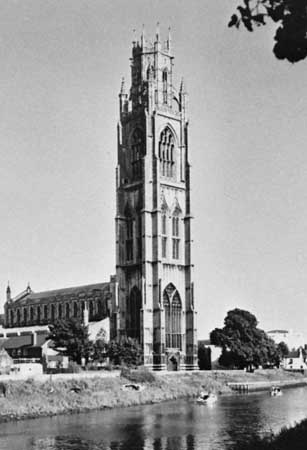 town and borough (district), administrative and historic county of Lincolnshire, England, on the River Witham on the northern margin in the Fens. Boston town has served as a small port since the 13th century, when, as a member of the Hanseatic League, it traded in wool and wine. With the progressive silting of the river and changing patterns of trade, the town's prosperity declined. It was from Boston that many of the Puritans set forth for the New World. Boston's church is a landmark for the surrounding flat country of the Fens. The tower, known as Boston Stump, is 272.5 feet (83 metres) high. The church itself is a Decorated-style building extensively restored since 1931. The contemporary importance of the town of Boston derives from its continued modest function as a port and from the presence of agricultural and cattle markets. Industries are based largely on agricultural processing. The surrounding borough is mostly rural and intensively cultivated. Area borough, 139 square miles (360 square km). Pop. (2001) town, 35,124; district, 55,739.
town and borough (district), administrative and historic county of Lincolnshire, England, on the River Witham on the northern margin in the Fens. Boston town has served as a small port since the 13th century, when, as a member of the Hanseatic League, it traded in wool and wine. With the progressive silting of the river and changing patterns of trade, the town's prosperity declined. It was from Boston that many of the Puritans set forth for the New World. Boston's church is a landmark for the surrounding flat country of the Fens. The tower, known as Boston Stump, is 272.5 feet (83 metres) high. The church itself is a Decorated-style building extensively restored since 1931. The contemporary importance of the town of Boston derives from its continued modest function as a port and from the presence of agricultural and cattle markets. Industries are based largely on agricultural processing. The surrounding borough is mostly rural and intensively cultivated. Area borough, 139 square miles (360 square km). Pop. (2001) town, 35,124; district, 55,739.Massachusetts, United States
Introduction
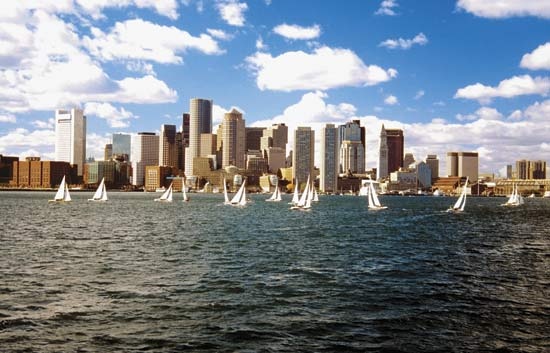
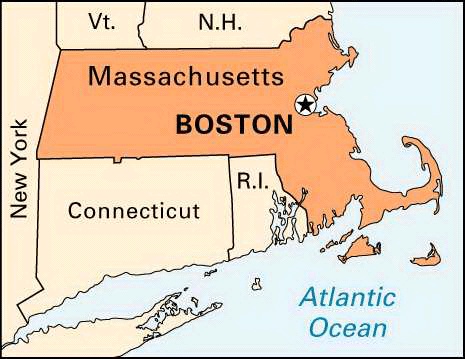 city, capital of the commonwealth of Massachusetts, and seat of Suffolk county, in the northeastern United States. It lies on Massachusetts Bay, an arm of the Atlantic Ocean. The city proper has an unusually small area for a major city, and more than one-fourth of the total—including part of the Charles River, Boston Harbor, and a portion of the Atlantic—is water. Area city, 46 square miles (119 square km). Pop. (2000) city, 589,141; Boston-Cambridge-Quincy MSA, 4,391,344; (2005 est.) city, 559,034; Boston-Cambridge-Quincy MSA, 4,411,835.
city, capital of the commonwealth of Massachusetts, and seat of Suffolk county, in the northeastern United States. It lies on Massachusetts Bay, an arm of the Atlantic Ocean. The city proper has an unusually small area for a major city, and more than one-fourth of the total—including part of the Charles River, Boston Harbor, and a portion of the Atlantic—is water. Area city, 46 square miles (119 square km). Pop. (2000) city, 589,141; Boston-Cambridge-Quincy MSA, 4,391,344; (2005 est.) city, 559,034; Boston-Cambridge-Quincy MSA, 4,411,835.Character of the city
 The area, the people, and the institutions within its political boundaries can only begin to define the essence of Boston. Its nickname “Beantown” has its origin in colonial times, when Boston, as a stop on a major trade route with the West Indies, had a steady supply of molasses from the Caribbean, thus leading to the creation of a popular dish that became known as Boston baked beans (beans baked in molasses). As a city and as a name, Boston is a symbol of much that has gone into the development of the American consciousness, and its presence reaches far beyond its immediate environs. As the spiritual capital of the New England states, as the progenitor of the American Revolution and the nation, and as the earliest centre of American culture, Boston has influenced the country for some three centuries. Though Boston, like New England in general, has played a lessening role in national life since the early 20th century, it has remained the focal point of what may be the most diversified and dynamic combination of educational, cultural, and medical and scientific activities in the United States.
The area, the people, and the institutions within its political boundaries can only begin to define the essence of Boston. Its nickname “Beantown” has its origin in colonial times, when Boston, as a stop on a major trade route with the West Indies, had a steady supply of molasses from the Caribbean, thus leading to the creation of a popular dish that became known as Boston baked beans (beans baked in molasses). As a city and as a name, Boston is a symbol of much that has gone into the development of the American consciousness, and its presence reaches far beyond its immediate environs. As the spiritual capital of the New England states, as the progenitor of the American Revolution and the nation, and as the earliest centre of American culture, Boston has influenced the country for some three centuries. Though Boston, like New England in general, has played a lessening role in national life since the early 20th century, it has remained the focal point of what may be the most diversified and dynamic combination of educational, cultural, and medical and scientific activities in the United States.Landscape
The Boston region's topography was largely shaped by the glaciers that covered the land during the last ice age. The city and its sheltered deepwater harbour sit in a basin that extends to Lynn in the north and Quincy in the south and is ringed by modest hills: the Middlesex Fells (north) to the Blue Hills (south). There are harder, higher surface rocks (mostly granites) on these northern and southern edges, while inside the basin the lower-lying rocks—commonly known as pudding stone—are found mostly below the surface in such areas as Roxbury, Newton, Brookline, Mattapan, West Roxbury, and Dorchester. The land, enormously compressed by the vast accumulation of glacial ice on it, has since been rebounding (rising up) at an extremely gradual rate.
Numerous drumlins (mounds of glacial debris) form low hills in the city and islands that dot the harbour. At the beginning of English settlement in the 17th century, the Shawmut Peninsula was called Trimountain (or Tramount) because of its dominating three-topped hill on the northwest corner near the mouth of the Charles River. Beacon Hill is its only surviving, though greatly reduced, remnant; the other portions were leveled to become landfill that added to the city's area in the 19th century.
Area of the colonial town
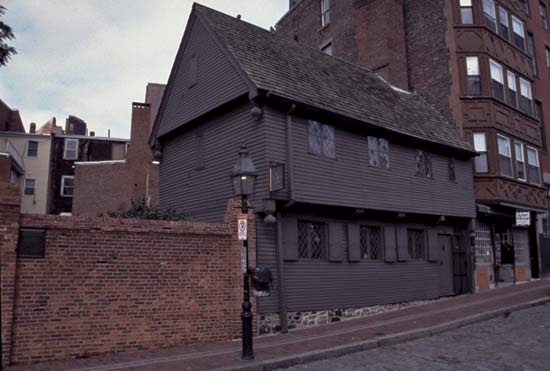 The hilly Shawmut Peninsula, upon which Boston was settled, originally was almost completely surrounded by water. It was connected with mainland Roxbury to the south by a narrow neck of land along the line of present-day Washington Street. To the west of the neck were great reaches of mudflats and salt marshes that were covered by water at high tide and known collectively as the Back Bay. The Charles River flowed through the Back Bay to Boston Harbor and separated the peninsula from the mainland to the north and west. To the east, Town Cove indented Boston's harbour front and divided the city into the North End and the South End. The centre of the colonial town was at the present Old State House (1711–47).
The hilly Shawmut Peninsula, upon which Boston was settled, originally was almost completely surrounded by water. It was connected with mainland Roxbury to the south by a narrow neck of land along the line of present-day Washington Street. To the west of the neck were great reaches of mudflats and salt marshes that were covered by water at high tide and known collectively as the Back Bay. The Charles River flowed through the Back Bay to Boston Harbor and separated the peninsula from the mainland to the north and west. To the east, Town Cove indented Boston's harbour front and divided the city into the North End and the South End. The centre of the colonial town was at the present Old State House (1711–47).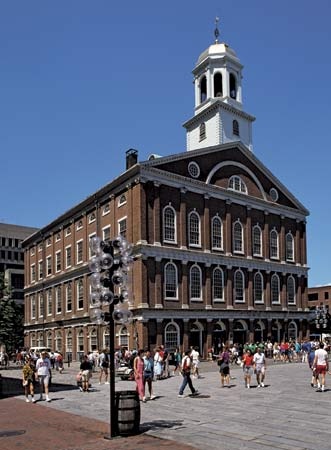 Although this original centre and the colonial South End have long been given over to offices and retail stores, a few 18th-century buildings remain: Faneuil Hall (1742–1805), the Old Corner Book Store (1711), the Old South Meeting House (1729), and King's Chapel (1750). The North End is the only part of the early town that has remained residential since the 1630 settlement. Colonial survivals such as the Paul Revere House (c. 1680) and Christ Church (1723)—the Old North Church from which lanterns revealed the route of the British march to Lexington in 1775—coexist with the busy life of a traditionally Italian American community.
Although this original centre and the colonial South End have long been given over to offices and retail stores, a few 18th-century buildings remain: Faneuil Hall (1742–1805), the Old Corner Book Store (1711), the Old South Meeting House (1729), and King's Chapel (1750). The North End is the only part of the early town that has remained residential since the 1630 settlement. Colonial survivals such as the Paul Revere House (c. 1680) and Christ Church (1723)—the Old North Church from which lanterns revealed the route of the British march to Lexington in 1775—coexist with the busy life of a traditionally Italian American community.The long shoreline, only a few minutes' walk from any part of the peninsula, provided ample space for wharves and shipyards. From the first years of settlement, the shoreline constantly encroached on the harbour as wharves were built and marshy coves were filled. West of the original settlement lay Boston Common, a tract that has remained public open space since its purchase by the town in 1634.
Postcolonial expansion
In the last years of the 18th century, when space in the city became scarce, a series of major changes began to transform the urban landscape. In that period of expansion, the architect Charles Bulfinch (Bulfinch, Charles), who for more than a quarter of a century was also the head of the town government, skillfully transformed an 18th-century English town into a 19th-century American city. Bulfinch designed the central portion of the present State House (1795–98), above Boston Common on Beacon Hill. The construction of the State House on this site led to the conversion of the upland pastures of Beacon Hill into a handsome residential district that has survived with relatively little change. Between the State House and Charles Street are several streets, including famous Louisburg Square, filled with many houses by Bulfinch and other leading 19th-century architects. The area is protected by historic district legislation and has been designated as the Beacon Hill Historic District.
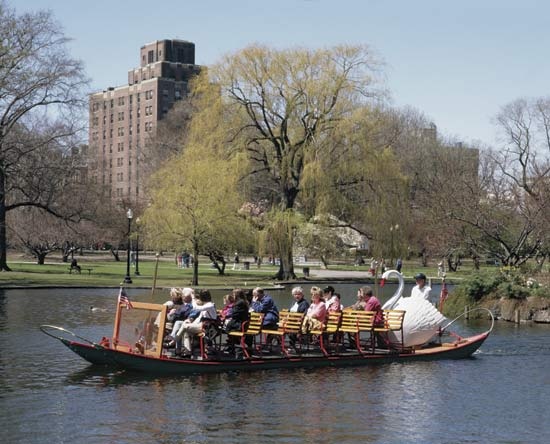 As pressures of population in the 19th century caused a growing demand for land, hills were leveled to fill in the coves. So much new land was created that the former peninsula has become an indistinguishable part of the mainland. Fill on both sides of the narrow neck that connected the peninsula with the mainland created a new South End. The waterfront was greatly extended, and the Back Bay was dammed (1818–21) to create tidal power for new mill sites. A causeway along the dam extended west from Boston Common to Sewall's Point, the present Kenmore Square, thus furnishing more-direct communication with the mainland. The filling of the Back Bay flats just west of the common created land that in the 1830s was laid out as the Public Garden. This became a splendidly planted area with an artificial pond that is still traversed by swan-shaped excursion boats in the summer.
As pressures of population in the 19th century caused a growing demand for land, hills were leveled to fill in the coves. So much new land was created that the former peninsula has become an indistinguishable part of the mainland. Fill on both sides of the narrow neck that connected the peninsula with the mainland created a new South End. The waterfront was greatly extended, and the Back Bay was dammed (1818–21) to create tidal power for new mill sites. A causeway along the dam extended west from Boston Common to Sewall's Point, the present Kenmore Square, thus furnishing more-direct communication with the mainland. The filling of the Back Bay flats just west of the common created land that in the 1830s was laid out as the Public Garden. This became a splendidly planted area with an artificial pond that is still traversed by swan-shaped excursion boats in the summer.The Back Bay mill basins never developed as their promoters had envisioned, partly because the construction of railway lines through them in the 1830s hindered the flow of water. The basins became a foul-smelling nuisance, and the Massachusetts legislature in 1857 authorized the filling of this extensive area. The plan adopted provided for four new streets parallel to the Mill Dam (Beacon Street), to be intersected by cross streets. Commonwealth Avenue, running west from the Public Garden and 200 feet (60 metres) wide with a park between its roadways, created the atmosphere of a Parisian boulevard. Since there were no hills left to cut down, gravel had to be brought in by train from pits some distance away in Needham. By the end of the 19th century the Back Bay was completely filled and built up with houses that were subject to uniform height limits and setbacks. The region today presents a picture of American architecture that is as consistent for the second half of that century as Beacon Hill is for the first. Although many Back Bay houses have been converted to apartments, offices, schools, or other uses, the region has retained a good deal of its original character, and further changes are subject to architectural control.
The Emerald Necklace
When the Back Bay was nearing completion during the 1880s, the American landscape architect Frederick Law Olmsted (Olmsted, Frederick Law) developed an imaginative and large-scale design for the city's parks. It linked the common, the Public Garden, and Commonwealth Avenue with Franklin Park south of Roxbury by way of a string of parks—including the Back Bay Fens—that combined water, woods, and meadows along an open park known as the Fenway, which followed the Muddy River between central Boston and Jamaica Plain. Included in this park system, known as the Emerald Necklace, was the Arnold Arboretum (Arnold Arboretum of Harvard University), a botanical outpost of Harvard University in Jamaica Plain. Around the turn of the 20th century, institutions such as the Boston Symphony Orchestra, the New England Conservatory of Music, the Museum of Fine Arts, and the Harvard Medical School and hospitals moved west to locations near the Back Bay Fens. The completion in 1910 of a dam that kept the harbour tides out of the Charles River converted the remaining unfilled portion of the Back Bay into a body of fresh water. The Charles River basin, surrounded by parkland and patterned on the Alster River basin in Hamburg, Ger., remains one of the most handsome, distinctive, and popular features of Boston.
Annexations
With the end of the American Civil War in 1865, large numbers of Boston residents, many of them Irish immigrants, abandoned the congested waterfront districts and moved into the nearby suburbs. Soon, many of these new districts sought to annex themselves to the city of Boston in order to obtain such services as water, sewers, schools, hospitals, police security, and fire protection. In 1868, Roxbury became a part of Boston; Dorchester followed two years later; and in 1873 Charlestown, Brighton, and West Roxbury were also annexed. The city's population jumped from 140,000 in 1865 to 341,000 in a decade—an increase of more than 200,000 people. Once a small community of some 1.2 square miles (3.2 square km) of land, Boston is now nearly 40 times its original size. These new communities, known as neighbourhoods, became parts of the city's ward system and were populated at first by groups of Irish Americans. Gradually, however, as new ethnic groups moved into Boston after the turn of the 20th century, they usually moved into one neighbourhood or another, making it distinctly their own. In this manner, South Boston and Charlestown were soon identified as distinctly Irish, the North End and East Boston as Italian, the Mattapan district as Jewish, and the Roxbury area as African American. Central Boston continued to be regarded as traditionally Anglo-Saxon Yankee.
The contemporary city
Until the mid-20th century, the low skyline of Boston was punctuated only by church steeples and by the Custom House Tower (1915), which, as a federal building, was not bound by the 125-foot (38-metre) height restriction that prevailed generally in the city. Modification of the building code and a construction boom brought about great changes in the 1960s and '70s, of which the first conspicuous example was the Prudential Center, with a 52-story tower. The first major effort in urban renewal in Boston, initiated early in 1958, led to the wholesale demolition of the West End, the displacement of people, and the disruption of neighbourhoods to make way for the apartment towers of Charles River Park. Unfavourable reaction to total destruction of such large areas without regard for the feelings of people led the city's redevelopment authority after 1960 to emphasize renewal rather than demolition and rebuilding. The Government Center, containing the new City Hall completed in 1968, in addition to federal, state, and private office buildings, thereby developed alongside Faneuil Hall and other adjacent historic buildings. Considerable private construction subsequently transformed much of central Boston. The John Hancock Tower, completed in 1976, overtopped the nearby Prudential Tower, while the Christian Science church (Church of Christ, Scientist) sponsored the reconstruction of large blocks of property near the First Church of Christ, Scientist (The Mother Church). Several high-rise office towers went up during the 1970s in Boston's financial district, and downtown waterfront renewal during the 1960s and '70s along Atlantic Avenue helped to open up the waterfront for commercial, residential, and recreational use and to preserve buildings of historical and architectural value. During the 1980s and '90s, many of Boston's older neighbourhoods, most notably the South End, underwent extensive renovation as they drew an increasingly affluent population. In the late 20th and early 21st centuries, other neighbourhoods outside the downtown area—many of which formerly had been populated by Irish and Italians—attracted increasing numbers of African American, Latino, and Asian residents.
The narrow and crowded streets of the central city are better suited for walking than driving, for Bostonians are incorrigible jaywalkers. The street markets around Faneuil Hall are as essential a part of the city as ever, while the surrounding modern offices and their workers provide a modern bustle and vitality.
People
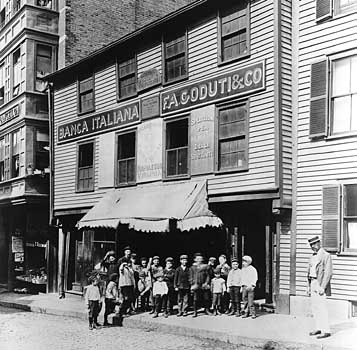 Between 1800 and 1900, Boston changed from a relatively simple and ethnically homogeneous seaport of some 24,000 inhabitants (mainly of English ancestry) to a city with a much more diverse population of more than 560,000. The burgeoning of the city's population during the 19th century was the result of a succession of immigrant waves that increased the total by at least one-fourth in each decade from 1810 to 1900. While the Irish were the most important immigrant group during the 19th century, from the late 1880s through the 1910s Boston also received a new wave of immigrants, mainly from southern and eastern Europe, including Italians and Jews. The traditional Yankee elite, of mainly English origin, remained in the central Boston neighbourhoods of Beacon Hill and Back Bay and dominated many of the city's economic institutions, while Irish, Italian, Jewish, and other immigrant groups occupied many of the outlying neighbourhoods and gained control over the city's political life.
Between 1800 and 1900, Boston changed from a relatively simple and ethnically homogeneous seaport of some 24,000 inhabitants (mainly of English ancestry) to a city with a much more diverse population of more than 560,000. The burgeoning of the city's population during the 19th century was the result of a succession of immigrant waves that increased the total by at least one-fourth in each decade from 1810 to 1900. While the Irish were the most important immigrant group during the 19th century, from the late 1880s through the 1910s Boston also received a new wave of immigrants, mainly from southern and eastern Europe, including Italians and Jews. The traditional Yankee elite, of mainly English origin, remained in the central Boston neighbourhoods of Beacon Hill and Back Bay and dominated many of the city's economic institutions, while Irish, Italian, Jewish, and other immigrant groups occupied many of the outlying neighbourhoods and gained control over the city's political life.Boston's ethnic patterns changed considerably after World War II with the growth of the city's African American population. In the early 20th century a relatively small black community was centred in the South End, but between 1940 and 1960 many African Americans migrated from southern states and occupied portions of Roxbury and Dorchester. From the 1940s through the '70s many Puerto Ricans arrived in Boston. Beginning in the late 1970s, a renewed wave of immigration brought further changes to the city's population. Most recently, the largest groups of immigrants have come from the Caribbean islands (particularly Haiti), from Central and South America, and from Asia (notably China and Vietnam); they have settled in the city's outlying neighbourhoods, as descendants of earlier immigrants moved to the suburbs. Ireland is still one of the single largest sources of immigrants, although that trend began slowing and even reversing in the early 21st century, when crackdowns on illegal immigration and stricter enforcement of existing regulations began affecting all immigrant groups.
Economy
Finance and industry
During the 19th century, industrial textile mills and shipbuilding concerns augmented the shipping and commerce that had dominated Boston's colonial economy. Investments in banking and railroads provided additional sources of wealth, while shipping lost importance during the mid-19th century. Railroad investments and the textile industry dominated the regional economy until the Great Depression of the 1930s, when textile factories moved to the South in search of cheaper labour and raw materials. During World War II, Boston's universities provided a source of scientific and technological talent to war-related industries, and Boston changed from “mill-based” to “mind-based” industries, with major corporations dominating electronics, telecommunications, and digital research. Later, Boston firms took the lead in software design, computer architecture, data processing, and biomedical technologies. Boston banks created high-technology investment companies connected with global financial institutions that made the city a world leader in equity fund management. Boston's universities remained an important part of the city's economy, and their medical schools and hospitals gave the city an especially robust health-care sector.
Transportation
The Boston Post Road, consisting of three routes, was one of the most heavily traveled of the early roadways. It opened to mail delivery between Boston and New York City in 1673. Today, the Massachusetts Bay Transportation Authority maintains a network of public subway, elevated, and surface lines. The subway system, begun in 1897, was the first in the country.
Some of the Boston region's other transportation facilities are under state control. The Massachusetts Port Authority, for example, operates Logan International Airport in East Boston—a busy centre for overseas as well as domestic flights—along with several regional airports. The Massachusetts Turnpike Authority supervises the operations of Interstate 90, the highway extending westward from Boston to New York state. The Metropolitan District Commission manages a system of regional parks and roadways.
Boston has not easily accommodated the growth of private automobile and truck traffic, which increasingly chokes the city, especially the narrow and winding downtown streets laid out in colonial times. For decades one of the city's weakest points in terms of traffic flow was the Central Artery, a six-lane elevated highway opened in 1959 that cut through downtown and isolated neighbourhoods. Increasingly, it became clear that the Central Artery was becoming unable to cope with continually growing vehicular traffic, and a major construction project—the Central Artery/Tunnel Project, commonly called the Big Dig—was begun in 1991. The task involved replacing the elevated highway through the city with an 8-to-10-lane underground expressway, rebuilding bridges, and boring a new tunnel under the harbour; the need to do so without crippling the city's essential functions and day-to-day life made it one of the most challenging infrastructure projects ever undertaken in the United States. Major construction on the Big Dig was completed in 2006, providing greater access to the formerly undeveloped South Boston waterfront area. There a newly created Seaport District featured a large convention centre, an international trade centre, the Institute of Contemporary Art, and a series of hotels, restaurants, and residential buildings.
Administration and society
Government
Throughout the colonial period, Boston was governed by a town meeting to which representatives of the community were regularly elected. In 1822, after a popular referendum, Boston became a city and acquired a city government. All “fiscal, prudential, and municipal concerns” of the city were vested in the mayor, a committee of 8 persons called the Board of Aldermen, and a Common Council of 48 members elected from the various wards of the city.
This system endured until 1909, when a new city charter was approved. The Board of Aldermen was abolished, and the council was reduced in size to nine at-large members. Mayoral elections were put on a nonpartisan basis, and the office of mayor was greatly strengthened by giving the incumbent a four-year term. With minor variations, this system continues to operate.
Boston is unique among the cities in the Bay State for the restrictions that have been placed on its power to manage its own finances and control its own regulatory agencies. In 1909, fearing municipal corruption, the Republican-controlled state legislature placed severe restrictions on local rule. The state created an independent finance commission to oversee the city's management and budget as well as to control the appointment of the city's police commissioner and members of the licensing board. Perhaps the most influential local authority in later years has been the Boston Redevelopment Authority, which directed major urban development projects during the 1960s and '70s.
Municipal services
During the 19th century, Boston organized its fire and police departments, established municipal services to centralize water supplies and safeguard the public health, and authorized a public works department to lay out streets and construct roads and bridges. In the 20th century, however, with the rapid expansion of the city and its surrounding urban communities, the greater Boston area came to depend on various state authorities, commissions, and quasi-public agencies for many vital resources. The Massachusetts Water Resources Authority, for example, coordinates the sewer and waterworks system that supplies more than 60 cities and towns in eastern Massachusetts.
Education and health
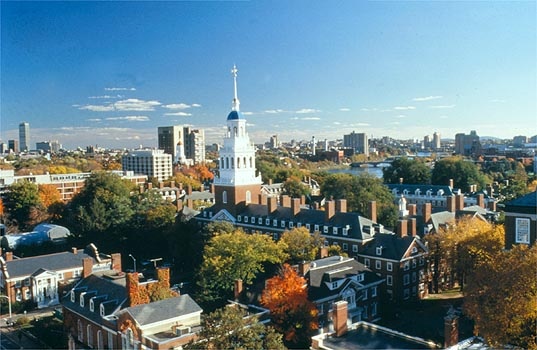 Universities, colleges, and schools of every kind fill several pages in the classified section of the Boston telephone directory. Boston University (founded 1869), Northeastern University (1898), Suffolk University (1906), and the Boston campus (1964) of the University of Massachusetts (Massachusetts, University of), as well as Simmons (1899), Emmanuel (1919), and Emerson (Emerson College) (1880) colleges, are based within the city, as are the Harvard University faculties of medicine, dentistry, public health, and business administration.
Universities, colleges, and schools of every kind fill several pages in the classified section of the Boston telephone directory. Boston University (founded 1869), Northeastern University (1898), Suffolk University (1906), and the Boston campus (1964) of the University of Massachusetts (Massachusetts, University of), as well as Simmons (1899), Emmanuel (1919), and Emerson (Emerson College) (1880) colleges, are based within the city, as are the Harvard University faculties of medicine, dentistry, public health, and business administration.The rest of Harvard (1636) and Radcliffe College (1879; now the Radcliffe Institute for Advanced Study at Harvard University) and the Massachusetts Institute of Technology (MIT; 1861) are just across the Charles River in Cambridge. Boston College (1863), a Jesuit institution that is a university in everything except name, is in Chestnut Hill, only a step beyond the city limits. Tufts University (1852), although based in Medford, has its medical school in Boston. Massachusetts General, among the oldest of hospitals in the United States, is joined by, among others, Beth Israel Deaconess, Children's, and Brigham and Women's hospitals and the New England Medical Center.
Cultural life
The arts
Boston has a rich and varied cultural life, and the love of music attracts many Bostonians throughout the year. The Boston Symphony Orchestra (BSO), founded in 1881, is one of the foremost orchestras in the world. The BSO performs at Symphony Hall during the winter months and at the Tanglewood Music Festival, in the Berkshire Hills of western Massachusetts, in July and August. The longtime conductor Arthur Fiedler (Fiedler, Arthur) made the BSO's Boston Pops series a local music institution; each spring, Bostonians crowd around café-style tables in Symphony Hall and listen to a mixture of classical and popular favourites. During the summer, the Pops also performs outdoors at the Hatch Shell along the Charles River; a much-anticipated annual event is the orchestra's Fourth of July concert, which culminates with Tchaikovsky (Tchaikovsky, Pyotr Ilyich)'s 1812 Overture. Noted Boston music schools include the New England Conservatory of Music (1867) and the Berklee College of Music (1945).
Boston's reputation as a cultural centre is built in large part on the prominent museums that are its patrimony. The Museum of Fine Arts (Fine Arts, Museum of), a major world institution (opened 1876), preserves and exhibits East Asian, Egyptian, and Classical collections as well as other important examples of paintings, prints, textiles, and the decorative arts. The Isabella Stewart Gardner Museum (Gardner Museum) (1903) in the Fenway has a notable collection of Italian Renaissance paintings and remains an important monument as well as a history of taste. Harvard University maintains a fine arts museum as well as several museums devoted to science and natural history. The Museum of Science (Science, Museum of) (1949) at Science Park, overlooking the Charles River basin, and the Children's Museum at Museum Wharf are aimed at the instruction of young people.
Among American cities, Boston is particularly noted for the abundance of its scholarly and public libraries. The Boston Public Library (1854) was the first major tax-supported free library in the United States. Since 1895 it has been housed in a building designed by the architectural firm of McKim, Mead, and White (McKim, Charles Follen). The library, with its fine collection of books, carries out many of its functions through branches spread throughout the city. The Boston Athenaeum (Boston Athenæum), a proprietary library founded in 1807, the Massachusetts Historical Society, the New England Historic Genealogical Society, the State Library, and the libraries of the colleges and universities in the area provide remarkable resources, while, across the Charles, Harvard has one of the greatest libraries for scholarship in the world.
Boston has a flourishing theatre district near the common that provides venues for both mainstream and more-offbeat shows. Broadway shows and professional stage productions are mounted at the Wilbur and Colonial theatres. The renovated Citi Performing Arts Center, which operates the Shubert and Wang theatres, provides facilities for grand opera and large theatrical productions. In addition to professional productions, there are numerous small playhouses and repertory theatres in the greater Boston area as well as notable dramatic productions at many of the area's colleges and universities, such as the Loeb Drama Center at Harvard (home of the American Repertory Theatre), the Kresge Auditorium at MIT, the Spingold Theater Center at Brandeis University, and the Robsham Theater Arts Center at Boston College.
Recreation
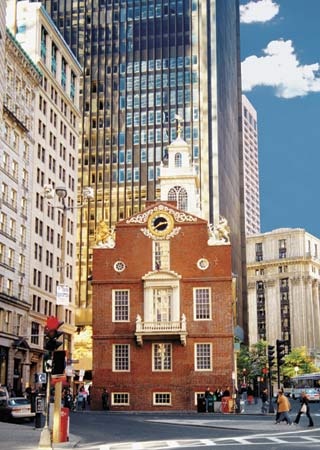 One of the typical forms of leisure activity in Boston is walking the crooked streets looking at the city and its architecture. Historic Quincy Market, the Boston Common and Public Garden, and the main commercial streets of the Back Bay and Beacon Hill, which are lined with outdoor cafés in summer, attract casual strollers and shoppers at all times of year. Boston has preserved many colonial-era buildings and an extraordinary number of fine 19th-century structures, yet in the city and its surroundings are a great variety of the works of the principal American and European architects of the second half of the 20th and early 21st centuries. Many tourists follow the Freedom Trail, a walking route through the historic section of the city, to such famous sites as the Paul Revere House, the Bunker Hill Monument, Faneuil Hall, the Old North Church, the Old State House, and the USS Constitution (“Old Ironsides”), a U.S. naval warship built in 1797. Similar walking tours have been developed for sites of literary and maritime significance as well as for sites highlighting the city's various ethnic communities.
One of the typical forms of leisure activity in Boston is walking the crooked streets looking at the city and its architecture. Historic Quincy Market, the Boston Common and Public Garden, and the main commercial streets of the Back Bay and Beacon Hill, which are lined with outdoor cafés in summer, attract casual strollers and shoppers at all times of year. Boston has preserved many colonial-era buildings and an extraordinary number of fine 19th-century structures, yet in the city and its surroundings are a great variety of the works of the principal American and European architects of the second half of the 20th and early 21st centuries. Many tourists follow the Freedom Trail, a walking route through the historic section of the city, to such famous sites as the Paul Revere House, the Bunker Hill Monument, Faneuil Hall, the Old North Church, the Old State House, and the USS Constitution (“Old Ironsides”), a U.S. naval warship built in 1797. Similar walking tours have been developed for sites of literary and maritime significance as well as for sites highlighting the city's various ethnic communities.Dining out is another popular pastime. There are several old and established restaurants that are frequented by visitors and natives alike. Several Boston institutions are legendary: Locke-Ober, known for its French cuisine since 1875; the Union Oyster House, Boston's oldest restaurant (1826), famous for its seafood; and Jacob Wirth, open since 1868 and serving German food. Established hotels feature well-known chefs and excellent dining rooms. The finest Italian food can be found in the North End, while Asian specialties abound in Chinatown. With the influx of immigrants from all parts of the world, visitors can find—around the city as well as in the neighbourhoods—a wide variety of ethnic restaurants featuring Japanese, Thai, Mexican, Indian, and African American specialties, among others. As a college town, Boston also provides an array of nightspots, bars, and lounges, located primarily in a stretch from Massachusetts Avenue to Kenmore Square.
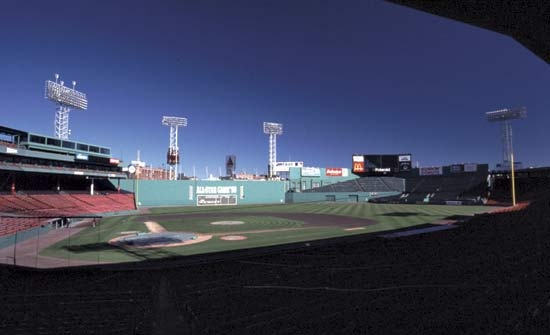 A true sports town, with professional teams in every major sport, Boston is also the centre of attention for the fans in the New England region. During the summer, the focus is on baseball, which since the turn of the 20th century has been the most popular sport overall. In 1903 thousands of Bostonians flocked to see the Boston Red Sox play the Pittsburgh Pirates in the first World Series, and the home team won several more championships following the opening of Fenway Park in 1912 before the team traded baseball great Babe Ruth (Ruth, Babe) to the New York Yankees in 1919. Thereafter followed one of the most notable dry spells in professional sports history, and the Sox—still playing in venerable Fenway—did not win another World Series until 2004.
A true sports town, with professional teams in every major sport, Boston is also the centre of attention for the fans in the New England region. During the summer, the focus is on baseball, which since the turn of the 20th century has been the most popular sport overall. In 1903 thousands of Bostonians flocked to see the Boston Red Sox play the Pittsburgh Pirates in the first World Series, and the home team won several more championships following the opening of Fenway Park in 1912 before the team traded baseball great Babe Ruth (Ruth, Babe) to the New York Yankees in 1919. Thereafter followed one of the most notable dry spells in professional sports history, and the Sox—still playing in venerable Fenway—did not win another World Series until 2004.In the fall, gridiron football is nearly as popular as baseball. Perhaps because of the strong tradition of such intercollegiate rivalries as the annual Harvard-Yale game, professional football was not really established until the New England (formerly Boston) Patriots (New England Patriots) moved to a new suburban stadium southwest of the city in 1971 after a decade spent playing at various Boston-area fields. The Bruins (Boston Bruins), the city's professional ice hockey team, became enormously successful after the arrival of the legendary defenseman Bobby Orr (Orr, Bobby) in the mid-1960s. Boston's professional basketball team, the Celtics (Boston Celtics), became one of the greatest professional sports dynasties in history. Beginning in the mid-1950s, with such dominating stars as Bill Russell (Russell, Bill), John Havlicek (Havlicek, John), and Larry Bird (Bird, Larry), the Celtics won 16 championships in 30 years. For years, fans of the Bruins and Celtics packed into the old Boston Garden, on Causeway Street, until it was demolished in 1997 and replaced by a new facility. The Bruins and the Celtics share the spotlight with outstanding local basketball and hockey teams, the latter participating in the annual Beanpot Tourney.
 Running has a tradition all its own in Boston. The Boston Marathon, held annually since 1887, is the world's oldest annual footrace. More than one million supporters line the hilly course, notably “Heartbreak Hill” in Newton, from the town of Hopkinton to Boylston Street in downtown Boston. The Boston Marathon has particular prestige as the only marathon in the United States for which runners must qualify.
Running has a tradition all its own in Boston. The Boston Marathon, held annually since 1887, is the world's oldest annual footrace. More than one million supporters line the hilly course, notably “Heartbreak Hill” in Newton, from the town of Hopkinton to Boylston Street in downtown Boston. The Boston Marathon has particular prestige as the only marathon in the United States for which runners must qualify.College crews row on the Charles River, and small boats sail on the wide basin between the Back Bay and the Cambridge shore. Except for the beaches and bathhouses in places such as South Boston, however, little recreational use has been made of the harbour since the 19th century, when Boston turned its back on the sea. However, since the late 20th century the Boston Redevelopment Authority has worked to reverse this trend. The downtown waterfront area, for example, now contains the state-of-the-art New England Aquarium, and a section of the former Charlestown Navy Yard has been designated part of Boston National Historic Park.
History
The colonial period
Settlement and growth
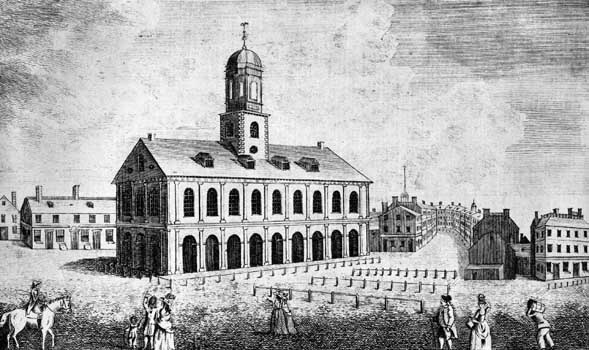 Boston was settled in 1630 by English Puritans (Puritanism) of the Massachusetts Bay Company, who, for religious and political reasons, put the Atlantic Ocean between themselves and the Church of England (England, Church of). Ostensibly founded as a commercial venture, the Massachusetts Bay Company, under its governor, John Winthrop (Winthrop, John), brought its charter—which it regarded as authorization to set up a self-governing settlement in the New England wilderness—along to the New World. The new town was named for Boston in Lincolnshire, the former home of many of the immigrants.
Boston was settled in 1630 by English Puritans (Puritanism) of the Massachusetts Bay Company, who, for religious and political reasons, put the Atlantic Ocean between themselves and the Church of England (England, Church of). Ostensibly founded as a commercial venture, the Massachusetts Bay Company, under its governor, John Winthrop (Winthrop, John), brought its charter—which it regarded as authorization to set up a self-governing settlement in the New England wilderness—along to the New World. The new town was named for Boston in Lincolnshire, the former home of many of the immigrants.Through necessity, New Englanders turned to the sea for a livelihood and became shipbuilders, merchants, seamen, and fishermen. The Shawmut Peninsula, on which Boston was settled, was an ideal setting for a seaport. It was described in 1634 by William Wood in his New England's Prospect as “fittest for such as can Trade into England, for such commodities as the Country wants, being the chiefe place for shipping and Merchandize.” With the triumph of the Puritan Party in England in 1648, people moved freely between New England and the homeland, and close ties of family and trade linked Boston and London. By the end of the 17th century Boston's fleet of seagoing vessels was exceeded only by those of London and Bristol in the English-speaking world. Boston held its place as the largest town in British North America until the mid-18th century, when it fell behind the faster-growing ports of Philadelphia and New York City.
Political life and revolutionary activity
 During its first 50 years, Boston was a homogeneous, self-governing Puritan community that the leaders of the Massachusetts Bay Company ruled as they saw fit. The three Puritan churches, established on the Congregational (Congregationalism) principle, accounted for almost all the organized religion in Boston. Religious dissidents were banished, and some Quakers who persisted in returning were hanged for their pains. The increasing prosperity of the colonial merchants brought Massachusetts Bay to London's special attention, and the company's charter was declared null and void in 1684. In 1686, with the arrival of Sir Edmund Andros (Andros, Sir Edmund) as the first royal governor of the Province of Massachusetts Bay, the authority of the crown was established in Boston itself. With this change, the Church of England first came to the town, and the Puritan isolation ended.
During its first 50 years, Boston was a homogeneous, self-governing Puritan community that the leaders of the Massachusetts Bay Company ruled as they saw fit. The three Puritan churches, established on the Congregational (Congregationalism) principle, accounted for almost all the organized religion in Boston. Religious dissidents were banished, and some Quakers who persisted in returning were hanged for their pains. The increasing prosperity of the colonial merchants brought Massachusetts Bay to London's special attention, and the company's charter was declared null and void in 1684. In 1686, with the arrival of Sir Edmund Andros (Andros, Sir Edmund) as the first royal governor of the Province of Massachusetts Bay, the authority of the crown was established in Boston itself. With this change, the Church of England first came to the town, and the Puritan isolation ended.Boston never proved wholly docile. When word of the Glorious Revolution (1688–89) reached them, the citizens on April 18, 1689, ejected Andros from office and imprisoned him. The memory of the autonomous first half-century lingered. When London endeavoured to enforce navigation laws and gain revenue from the Boston trade at the expense of the colonies, the aggrieved inhabitants resisted what they saw as unlawful authority. Disaffection grew after passage of the Stamp Act by Parliament in 1765, and the governor's house was stormed and gutted, an act that destroyed many irreplaceable records of the colony's history. The Boston Massacre of 1770, in which British troops fired on a crowd of civilian hecklers and killed several persons, and the Boston Tea Party of 1773, in which colonists disguised as American Indians dumped three shiploads of tea into Boston Harbor, became renowned events marking the growth of unrest before the American Revolution.
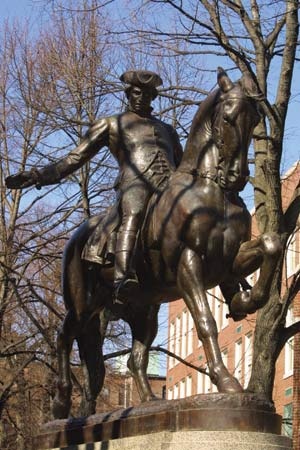 In April 1775, amid the escalating climate of hostility, the British military sent troops to Concord to destroy military stores, and patriot Paul Revere (Revere, Paul) undertook his famous ride from Boston to Lexington to warn the colonists there. The die was cast for the outbreak of hostilities with the confrontations and exchange of shots at Lexington and Concord (Lexington and Concord, Battles of) on April 19. When George Washington (Washington, George)'s army besieged the British in Boston during the following winter, normal life in the town was suspended. On March 17, 1776, impelled by Washington's artillery positioned on Dorchester Heights, British troops and officials left. Loyalist supporters of the crown, including a number of the principal merchants, accompanied them. A constitution was framed in 1780, and John Hancock (Hancock, John) was elected the first governor of the Commonwealth of Massachusetts.
In April 1775, amid the escalating climate of hostility, the British military sent troops to Concord to destroy military stores, and patriot Paul Revere (Revere, Paul) undertook his famous ride from Boston to Lexington to warn the colonists there. The die was cast for the outbreak of hostilities with the confrontations and exchange of shots at Lexington and Concord (Lexington and Concord, Battles of) on April 19. When George Washington (Washington, George)'s army besieged the British in Boston during the following winter, normal life in the town was suspended. On March 17, 1776, impelled by Washington's artillery positioned on Dorchester Heights, British troops and officials left. Loyalist supporters of the crown, including a number of the principal merchants, accompanied them. A constitution was framed in 1780, and John Hancock (Hancock, John) was elected the first governor of the Commonwealth of Massachusetts.Boston after 1776
Adjustment to independence
Independence gravely imperiled Boston's maritime trade, for, at the close of the Revolution, Boston merchants automatically became foreigners in the ports of the British Empire. Thus, survival depended on finding new channels of trade. Sending ships to distant and hitherto unfamiliar ports solved the crisis. The development of the China trade and other new routes, such as those to India, raised Boston to greater prosperity than ever before.
Throughout the first half of the 19th century, maritime commerce produced substantial fortunes in the city, which were supplemented by others achieved in mercantile and manufacturing pursuits. Bostonians in the 1810s began to establish textile mills, first at Waltham in 1813 and then in new towns to the north of the city along the Merrimack River, where waterpower was plentiful. The advent of railroads in the 1830s brought these once-distant towns suddenly closer. The burgeoning of Boston's population was the result not only of maritime commerce and manufacturing but also of the unanticipated arrival of immigrants from Europe in such numbers that the city grew more than 20-fold during the 19th century. By 1822 the traditional form of government—in which a board of selectmen administered the decisions reached by the vote of all citizens at an annual town meeting—had become unmanageable, and the Massachusetts legislature granted a city charter.
The era of culture
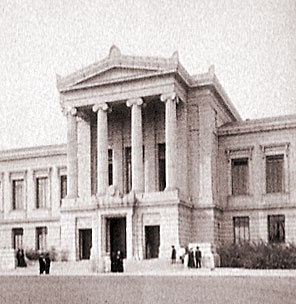 During the early 19th century Boston also assumed a focal position in the religious and educational life of the new nation. The rapid and large-scale infusion of immigrant groups and the loss of dominance by the Congregational descendants of the Puritan settlers were major factors in the change.
During the early 19th century Boston also assumed a focal position in the religious and educational life of the new nation. The rapid and large-scale infusion of immigrant groups and the loss of dominance by the Congregational descendants of the Puritan settlers were major factors in the change.By the end of the 19th century Roman Catholics outnumbered Protestants in Boston. Meanwhile, during the early 19th century, reform movements within the dominant Congregational church gave rise to the new, more-liberal denomination of Unitarianism. Unitarians were among the leading figures in the philosophy of Transcendentalism, which affected a great part of the region's artistic output and thought for much of the century; in the abolitionist (abolitionism) movement championed by the outspoken writer and editor William Lloyd Garrison (Garrison, William Lloyd) and others; and in liberal high-mindedness in social causes, which preoccupied many 19th-century Bostonians at a time when others were simply making money with great Yankee diligence. In the second half of the 19th century, the city was also the place where Christian Science was founded by Mary Baker Eddy (Eddy, Mary Baker). It remains the site of The Mother Church and the international headquarters of the faith.
Educational and cultural institutions had a similarly rapid growth. Across the Charles River in present-day Cambridge, a college had been founded in 1636 to provide the infant colony with religious scholars and ministers. It was named for the Charlestown minister John Harvard (Harvard, John), who bequeathed his library to the institution in 1638, and was the sole college in the area until the third quarter of the 19th century. Though Harvard University retained the most prestigious position throughout the century, a host of other major institutions of higher learning were founded, and Boston became synonymous nationally with scholarship and cultural refinement. It also became the mecca for persons—from abroad or from the “less civilized” parts of the country outside New England—who sought these qualities amid the bustling commercialism and rambunctious growth that characterized much of the United States in the 19th century.
Financial growth
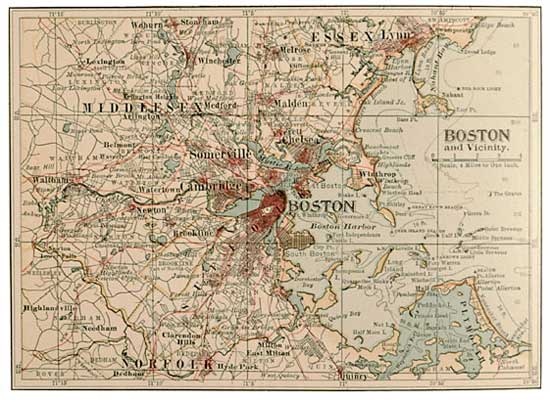
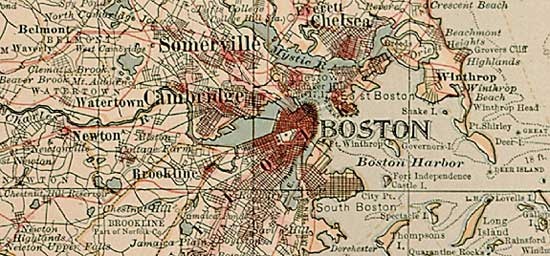
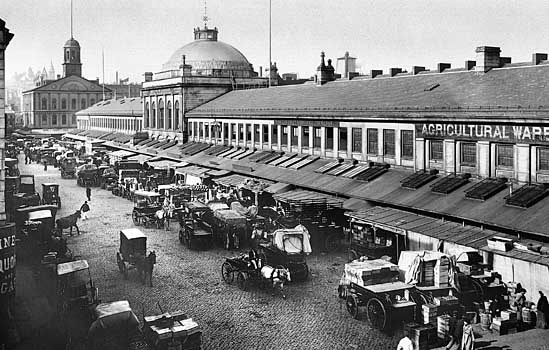 The opening of the Erie Canal in 1825, which gave New York City easy access to the North American interior, and later the American Civil War (1861–65), which cut off Boston's access to Southern cotton, put an end to shipping as a major consideration in the life of Boston. Banking and investment in manufacturing, railroads, and the development of the rapidly expanding frontier superseded maritime commerce as the principal occupation of Boston in the second half of the 19th century. In the early 20th century, however, the business horizons contracted. Though large sums of money continued to be invested outside of New England, fewer distant companies were controlled from Boston. The city's financial capital was still strong, but the rising strength of New York City and Chicago and of the developing states of the American West gradually reduced the proportion of capital that Boston could muster. Nevertheless, Boston's financial management firms showed a skill in investment that caused them to be well regarded in other parts of the country. This led eventually to a major growth of those Boston companies that administered what are now called mutual funds (mutual fund). Thus, the “prudent man,” whether in a private trustee's office or an investment company, survived as a Boston asset, whereas the textile mills and railroads proved to be less permanent. The textile industry passed into crisis in the 1920s, and the region's industrial centres, created by Boston investment, entered on decades of hardship. Some mills went out of business entirely, while others moved to the South in search of cheaper labour and raw materials.
The opening of the Erie Canal in 1825, which gave New York City easy access to the North American interior, and later the American Civil War (1861–65), which cut off Boston's access to Southern cotton, put an end to shipping as a major consideration in the life of Boston. Banking and investment in manufacturing, railroads, and the development of the rapidly expanding frontier superseded maritime commerce as the principal occupation of Boston in the second half of the 19th century. In the early 20th century, however, the business horizons contracted. Though large sums of money continued to be invested outside of New England, fewer distant companies were controlled from Boston. The city's financial capital was still strong, but the rising strength of New York City and Chicago and of the developing states of the American West gradually reduced the proportion of capital that Boston could muster. Nevertheless, Boston's financial management firms showed a skill in investment that caused them to be well regarded in other parts of the country. This led eventually to a major growth of those Boston companies that administered what are now called mutual funds (mutual fund). Thus, the “prudent man,” whether in a private trustee's office or an investment company, survived as a Boston asset, whereas the textile mills and railroads proved to be less permanent. The textile industry passed into crisis in the 1920s, and the region's industrial centres, created by Boston investment, entered on decades of hardship. Some mills went out of business entirely, while others moved to the South in search of cheaper labour and raw materials.Development of the contemporary city
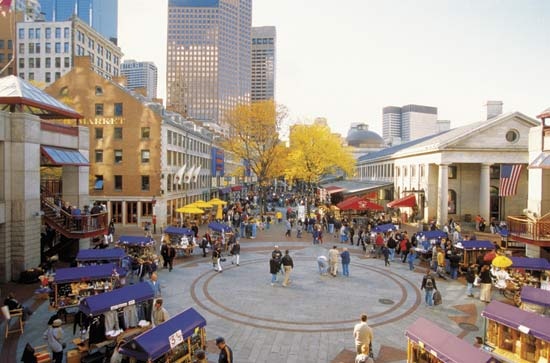 After the Civil War, immigration transformed Boston's social and political life. Irish political leaders, trading votes for favours, gained increasing power and offered their people social and economic advancement. By 1902 the Irish had elected two Irish-born candidates as mayors of the city, and in 1914 James Michael Curley (Curley, James Michael) won the first of four nonconsecutive terms of office, dominating Boston politics for the better part of the next 40 years. Resentful of Curley and opposed to what they regarded as his spendthrift ways, Boston's Yankees closed their banks and their pocketbooks to his pleas for money and refused to acknowledge his legitimacy as mayor. During the 1930s and '40s, the impasse between the Irish-Catholic Democrats (who controlled the political system) and the economically powerful Protestant Yankee Republicans worsened the city's economic decline and the deterioration of its infrastructure.
After the Civil War, immigration transformed Boston's social and political life. Irish political leaders, trading votes for favours, gained increasing power and offered their people social and economic advancement. By 1902 the Irish had elected two Irish-born candidates as mayors of the city, and in 1914 James Michael Curley (Curley, James Michael) won the first of four nonconsecutive terms of office, dominating Boston politics for the better part of the next 40 years. Resentful of Curley and opposed to what they regarded as his spendthrift ways, Boston's Yankees closed their banks and their pocketbooks to his pleas for money and refused to acknowledge his legitimacy as mayor. During the 1930s and '40s, the impasse between the Irish-Catholic Democrats (who controlled the political system) and the economically powerful Protestant Yankee Republicans worsened the city's economic decline and the deterioration of its infrastructure.After Curley's final defeat in 1949, a series of moderate Irish-Catholic mayors worked to bridge the gap between Yankees and Irish at the same time that the region's new technology-centred economy began to expand. Greater funding from state and federal agencies and increased private investment produced a building boom that rapidly transformed the old city. Largely excluded from these alliances, however, was the city's growing African American population. During the 1960s, African Americans demanded equal rights in housing, economic opportunities, and education. In 1974, in order to achieve racial integration in the public schools, a federal judge ordered that students be bused, and subsequent court orders mandated the integration of the city's public housing. Many white residents fiercely resisted integration, and for nearly a decade strikes, boycotts, and ethnic violence occurred in several of Boston's white neighbourhoods. By 2000 economic prosperity and generational change had reduced racial antagonisms, and an increasingly cosmopolitan Boston enjoyed a reputation for cultural and economic vitality.
Boston is one of the great historic cities of the United States, but it is not frozen in time; it has remained a vital and evolving metropolis. Having survived generations of political struggle, industrial change, and social turmoil, the city has become a leader in computer technology, a centre for medical research, a focal point of higher education, and an urban community that is in the process of even further expansion and development. The future challenge for Boston is to adapt further to accommodate multinational enterprises and modern technologies without losing its own distinctive identity as a city whose historical traditions, literary preeminence, and high cultural standards once led it to be hailed as the “Athens of America.”
Additional Reading
Geography
Michael P. Conzen and George K. Lewis, Boston: A Geographical Portrait (1976), is a study of demographic changes. Walter Muir Whitehill and Lawrence W. Kennedy, Boston: A Topographical History (1968; reissued 2000), describes the physical changes in Boston from settlement to the present. James Oliver Horton and Lois E. Horton, Black Bostonians, rev. ed. (1999), studies the life and community of African Americans before the Civil War. Oscar Handlin, Boston's Immigrants (1941; rev. and enlarged ed., 1991), analyzes the response of immigrants to their challenges; Thomas H. O'Connor, The Boston Irish (1995), traces the political history of the Irish; Stephen Puleo, The Boston Italians (2007), is a colourful saga of Boston's Italian immigrants; and Barbara Solomon, Ancestors and Immigrants (1956, reprinted 1989), examines the response of native Bostonians to European immigrants. Jonathan D. Sarna, Ellen Smith, and Scott-Martin Kosofsky (eds.), The Jews of Boston, rev. ed. (2005), is a lavishly illustrated study of the Jewish experience. Bernard Bailyn, The New England Merchants in the Seventeenth Century (1955; reissued 1979); and Samuel Eliot Morison, The Maritime History of Massachusetts, 1783–1860 (1921; reissued 1979), give the essentials about Boston shipping. Thomas H. O'Connor, Lords of the Loom (1968), describes the origins of the textile industry. Harold Kirker, Bulfinch's Boston, 1787–1817 (1964); and Walter Harrington Kilham, Boston After Bulfinch (1946), illustrate post-Revolutionary architectural changes. Barry Bluestone and Mary Huff Stevenson (eds.), The Boston Renaissance (2000), provides a detailed economic analysis of Boston at the turn of the millennium.
History
Alex Krieger and David Cobb (eds.), Mapping Boston (2001), presents Boston's history in historical maps. Justin Winsor (ed.), The Memorial History of Boston, 1630–1880, 4 vol. (1880–81), is an excellent reference on Boston's early history. Elisabeth M. Herlihy et al. (eds.), Fifty Years of Boston (1932), is a sequel for the years 1880–1930. Ronald P. Formisano and Constance K. Burns (eds.), Boston, 1700–1980 (1984), examines Boston's political history. Thomas H. O'Connor, The Hub: Boston Past and Present (2001), is a survey from colonial times to the present day. Van Wyck Brooks, The Flowering of New England (1936, reissued 1985); Henry Steele Commager, Theodore Parker (1936, reissued with a new introduction 1967); and Arthur Meier Schlesinger, The American as Reformer (1950, reissued with a new preface 1968), focus on the antebellum reform movements. Thomas H. O'Connor, Civil War Boston (1997), explores the effects of the conflict on the civilian population. Jack Beatty, The Rascal King (1992), is a lively account of one of Boston's most influential mayors, James Michael Curley; while James M. O'Toole, Militant and Triumphant (1992), offers a study of the city's Roman Catholic archbishop from 1907 to 1944, William Cardinal O'Connell. J. Anthony Lukas, Common Ground: A Turbulent Decade in the Lives of Three American Families (1985), presents Boston's busing and integration crisis as experienced by families of varying class and ethnic backgrounds; and Ronald P. Formisano, Boston Against Busing (2004), examines the city's busing crisis in terms of ethnicity and class.
- Elda
- Eldad ben Mahli ha-Dani
- Elda Emma Anderson
- Eldegüzid Dynasty
- elder
- Elder, John
- Elder, Kate
- Elder, Lonne, III
- Elder Olson
- Elders, Joycelyn
- E.L. Doctorow
- Eldon, John Scott, 1st Earl of, Viscount Encombe Of Encombe, Baron Eldon Of Eldon
- El Dorado
- Eldorado
- Eldoret
- Eldridge Cleaver
- Eldridge, Roy
- Elea
- Eleanor Clarke Slagle
- Eleanor Farjeon
- Eleanor Glueck, Sheldon; and Glueck
- Eleanor Hodgman Porter
- Eleanor Holmes Norton
- Eleanor Medill Patterson
- Eleanor of Aquitaine